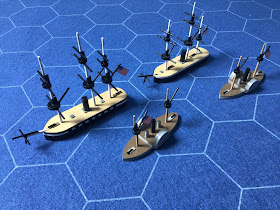Between 1592 and 1598, Japan invaded Korea twice, with the ultimate aim of conquering China. The expectation that Korea could be subdued easily en route to China but ultimately this was not the case. The Koreans, assisted by the Chinese, fought the vaunted Samurai armies to a standstill until they finally withdrew in 1598, following the death of the Taiko: Toyotomi Hideyoshi.
The two invasions were marked by unbelievably savage fighting on land - in which the Koreans certainly gave as good they got - and some quite remarkable battles at sea. At it is the war at sea that has formed a new post ACW project for me for which, mercifully, I will not be making the models!
The starter set from MT Miniatures with the list of contents listed on the box.
The Indefatigable David Manley drafted the rules which come in the starter set as well as being available on Wargames Vault under his Long Face Games label. He has also penned a set designed for large scale actions of the period called “Those Who Seek Death” as well as a couple of scenario PDFs. Aside from the rules, David has also included a potted history of the war as well as descriptions of the main ship types - in short everything one would need to get started in the period.
Game accessories - all laminated but needing to be carefully cut out
The ships that come with the starter set (1:1200th scale white metal) - needless to say I have expanded the choice and number available somewhat!
A painting guide for the Korean ships - note the famous ‘turtle ship’ in the centre….
….and also for the Japanese.
The ‘Imjin War’ and the later ‘Chongyu War’ (essentially the first and second invasion respectively) are not exactly mainstream naval history in the West but a very useful history of the period has been penned by the renowned expert on matters Far Eastern - Stephen Turnbull. By chance I saw a copy of this on ebay for next to nothing and immediately hoovered it up - and am really glad that I did! Although it is not a naval history as such, the exploits of the famous Korean Admiral Yi Sun-sin - celebrated as a national hero in the same way that Nelson is - with his turtle ships against the Japanese invading forces feature throughout.
A really useful book on the period - as are his other titles, primarily focussed on the Samurai
In a nutshell the Koreans largely dominated the naval scene wherever they found the Japanese ships so on the face of it the conflict would appear to be pretty one-sided. However, whilst the Koreans had stronger ships with better artillery, the Japanese had numbers, lighter and possibly handier ships (although with far fewer guns) and a willingness to get into hand to hand combat wherever possible. It was the outstanding leadership of Admiral Yi that provided the command expertise to the technological edge the Koreans possessed. The Japanese did have a few successes but not against Admiral Yi.
A modern replica of a Korean ‘Geobukseon’ - the ‘Turtle Ship’.
Gaming Thoughts
I must admit that this is not a period of naval warfare I would have considered were it not for David Manley’s rules and the models from MT Miniatures. In fact I would go further and say that I had never even heard of such a conflict other than as a mention in the book Shogun by James Clavell!
Despite the relatively obscure nature of this conflict, at least in the West, there is plenty to get one’s naval teeth into. Much of the combat was fought in sight of land so there is scope for some terrain in the form of fishing villages and small islands etc. The ships are quite simple in terms of design and paint scheme (a BIG advantage for me!) and have a distinctive look about them. There is little rigging to speak of and the ships use both sails and oars for propulsion. There are plenty of exotic weapon types in use and even early mines! Aside from the Koreans and Japanese there is also the Chinese including the inevitable war junk - a model that is useful for all sides.
I like the two differing tactical approaches so you have the ‘stand off and batter using gunfire’ doctrine used by the Koreans as opposed to the faster ‘get up close, board and butcher’ system favoured by the Japanese.
I have fancied tackling something 16th century based from a naval perspective but had never considered this conflict but I reckon it will be a lot of fun in an anarchic sort of way.
The land side of the war could possibly be catered for using Command and Colours: Samurai Battles although there are no rules that I am aware of that cater for the Koreans, or the Chinese for that matter. A trawl through the various facebook groups that cover the Command and Colours series may prove fruitful but that will be for another day.
First things first though - ACW and DTPIW!

















































